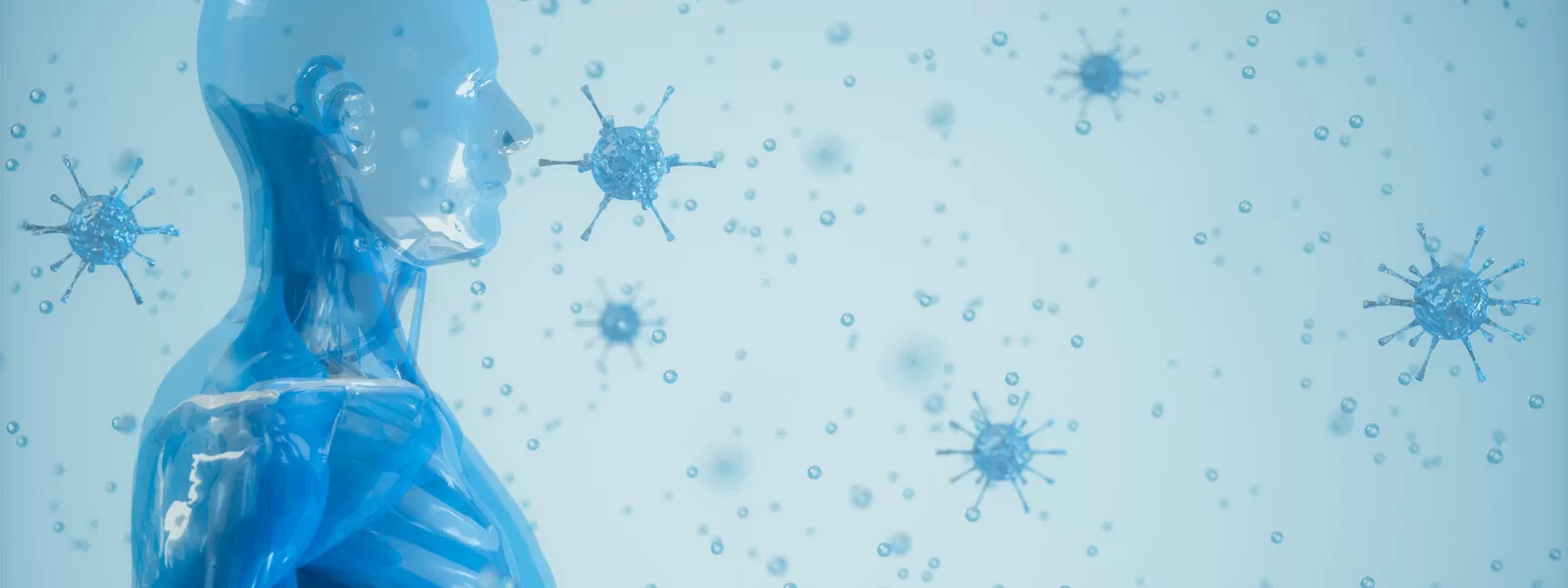How do Viruses Make us Sick?

We’ve all heard a lot about viruses lately, but what exactly are they? Viruses are bundles of nucleic acid—DNA or RNA—that are enclosed by a protein shell known as a capsid.1 By some measures the most abundant life form on earth,1 viruses lurk everywhere; experts estimate that they are 10 times more numerous than bacteria.2 And while individual viral particles, called virions,3 are too small to be seen under a microscope,2 when grouped together they can do outsize damage to people and animals.
How do viruses enter the body?
Viruses are unable to reproduce by themselves. In fact, they barely qualify as living things when outside of a host.1 But these parasites are well designed to infiltrate host cells and replicate copiously.
First, a virus finds an entry point on the surface of a host’s body, typically in the respiratory tract, including the mouth and nose. This is by far the most common route, particularly for pathogens such as rhinoviruses, coronaviruses, and influenza viruses.4 Microbes such as enteroviruses often get in through the alimentary canal while a person is eating or drinking; human immunodeficiency virus (HIV), hepatitis, and herpes may gain entry by way of the urogenital area during sexual activity. Other points of entry for viruses include the surface of the eyeball, and skin that has an abrasion or injury; they cannot penetrate intact skin. Mucus linings in the throat, gastrointestinal tract, and genital tract provide protection against viruses, but they can still make their way through mucus.
How viruses travel through the body
Once a virus gets into a host’s body, it travels along the surfaces of cells until its proteins begin to bind with receptors on the cells. The virus and the cells then fuse, allowing the DNA or RNA inside the virus to enter the cells, where it begins to reproduce. If enough viral matter is able to penetrate host cells without being deactivated by a host’s immune system or other antiviral mechanism, infection begins in earnest.3
The replicating virus may stay at the entry site or it may spread to other cells and tissues in the body, often by entering the bloodstream. This bloodstream-enabled spread allows the virus to have a far reach inside the body. Viruses may spread via nerve endings to attack the nervous system and may infiltrate organs as well.4
How the immune system reacts to viruses
The immune system reacts to the injury of these bodily cells by revving up, causing symptoms such as fever and chills. While we sometimes worry about running a fever, an elevated temperature generally is considered a protective response that works to destroy invasive microbes. One study revealed that patients entering the intensive care unit who ran a mild to moderate fever during their first 24 hours there did better than those who didn’t have a fever or whose fever was extreme.5 And while chills—which typically occur along with fever—may make you feel cold, they also happen because your core temperature is raised in order to fight off your infection.6
References:
- “What’s a Virus, Anyway? Part 1: The Bare-Bones Basics.” Stanford Medicine Scope, 2 April 2020. https://scopeblog.stanford.edu/2020/04/02/whats-a-virus-anyway-part-1-the-bare-bones-basics/.
- “Virus.” National Human Genome Research Institute. https://www.genome.gov/genetics-glossary/Virus.
- Cohen, Fredric S. “How Viruses Invade Cells.” Biophysical Journal, 110(5):1028-1032, 8 March 2016. https://www.ncbi.nlm.nih.gov/pmc/articles/PMC4788752/#:~:text=Viruses%20initially%20stick%20to%20cell,two%20membranes%20would%20remain%20distinct.
- Racaniello, Vincent. “Viral Pathogenesis.” Columbia University. http://www.columbia.edu/itc/hs/medical/pathophys/id/2004/lecture/notes/pathogenesis_Racaniello.pdf.
- Walter, Edward James, et al. “The Pathophysiological Basis and Consequences of Fever.” Critical Care 20(200), 2016 July 14. https://ccforum.biomedcentral.com/articles/10.1186/s13054-016-1375-5.
- UPMC Health Beat. “Why do I Have the Chills?” 31 August, 2016. https://share.upmc.com/2016/08/why-do-i-have-the-chills/#:~:text=Causes%20of%20the%20Chills,likely%20also%20cause%20the%20chills.





